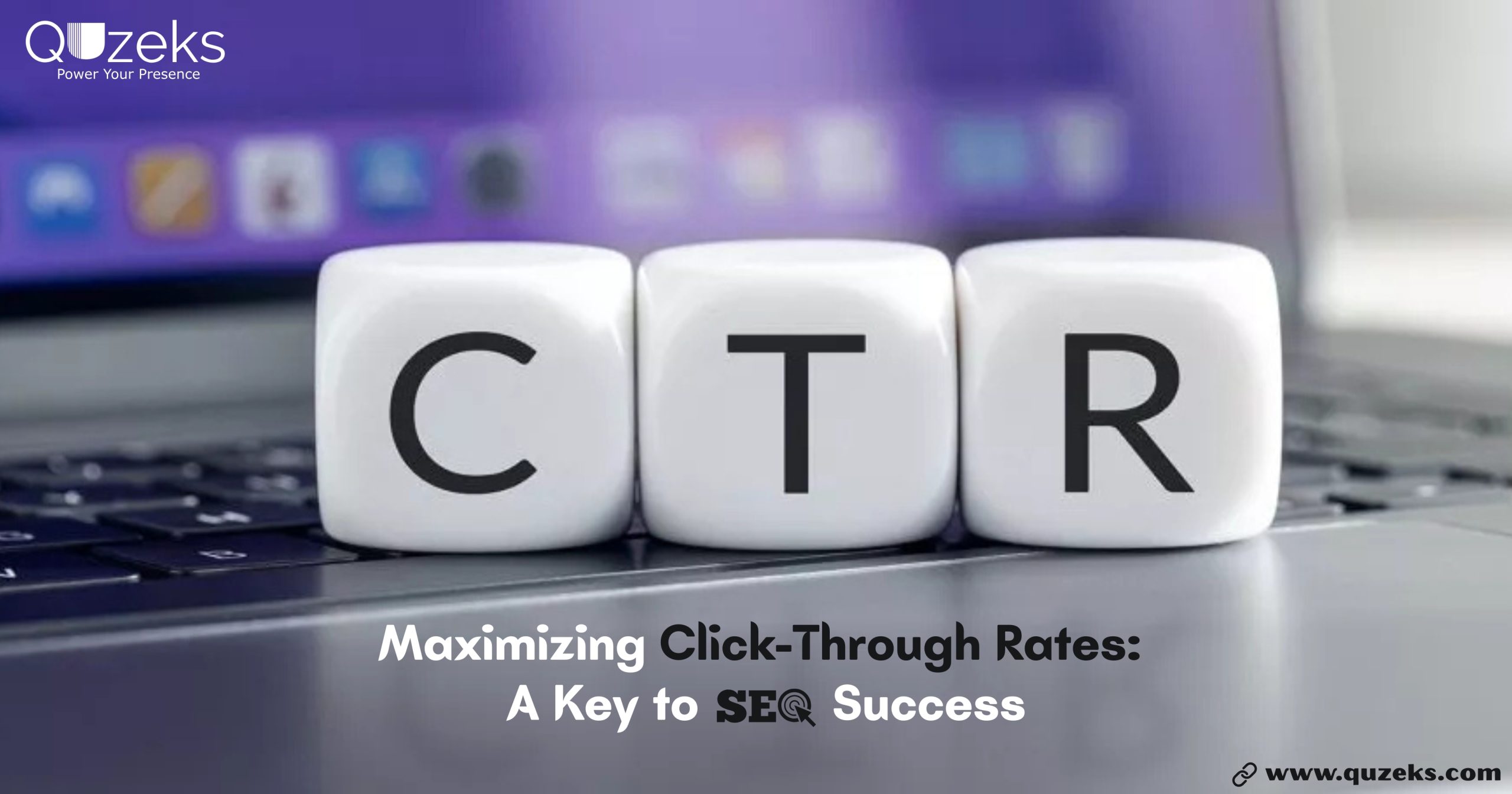In the competitive digital landscape, securing a high position on search engine results pages (SERPs) is only half the battle. Equally important is enticing users to click on your Link—a Click-Through Rate (CTR) metric. A higher CTR improves website traffic and informs search engines that your content is valuable, potentially raising your ranking.
What is CTR (Click-Through Rate)?
Click-Through Rate (CTR) is a metric that quantifies the percentage of users who click on a specific link compared to the total number of users who view it. In SEO, CTR typically refers to the ratio of clicks to impressions for a web page listed in search engine results pages (SERPs). For instance, if your webpage appears 1,000 times in search results and receives 50 clicks, your CTR would be 5%.
This metric serves as an indicator of how effectively your search listing attracts user attention and prompts action. A higher CTR indicates that your title and meta description are captivating and relevant to users’ search queries, encouraging them to visit your website.
Why is CTR Important for SEO?
CTR plays a pivotal role in SEO for several reasons:
- Indicator of Relevance: Search engines aim to provide users with the most relevant results. A high CTR signals that users find your listing pertinent to their search intent, which can positively influence your rankings.
- Enhanced Visibility: Listings with higher CTRs are more likely to be promoted by search algorithms, leading to increased visibility and traffic.
- Improved User Engagement: A compelling listing that garners clicks often leads to better user engagement on your site, reducing bounce rates and increasing the likelihood of conversions.
- Competitive Advantage: A higher CTR can set your content apart in competitive niches, drawing more traffic even if your ranking is slightly lower than competitors.
- Feedback Loop: Monitoring and optimizing CTR provides valuable insights into user behavior, allowing you to continuously refine your content and SEO strategies.
Practical Strategies to Enhance CTR
Here are eight effective strategies to enhance your CTR and achieve SEO success:
1. Craft Compelling Title Tags and Meta Descriptions
Your title tag and meta description are users’ first impressions of your content. To make them count:
- Be Clear and Concise: Make sure your title appropriately conveys the page’s information by being clear and concise. Avoid ambiguity that might confuse readers.
- Incorporate Keywords Naturally: Use relevant keywords to signal the content’s relevance to search queries.
- Invoke Curiosity: Phrases like “Discover how…” or “Learn the secrets to…” can pique interest.
- Include Numbers or Brackets: Titles with numbers (e.g., “5 Tips…”) or brackets (e.g., “[Guide]”) often attract more clicks.
By optimizing these elements, you can make your listings more appealing and informative, encouraging users to choose your Link over others.
2. Utilize Structured Data for Rich Snippets
Structured data, implemented through schema markup, helps search engines understand your content better and can enhance your listings with rich snippets. These may include:
- Star Ratings: Displaying average ratings can build trust.
- Product Information: Showcasing price, availability, or other details.
- Event Details: Highlighting dates, locations, and times.
Rich snippets make your listings more informative and visually appealing, which can significantly increase CTR.
3. Optimize URL Structure
A clean and descriptive URL can influence a user’s decision to click. Consider the following:
- Keep It Short and Readable: Keep URLs short so they are easier to read, remember, and share. They also limit the possibility of mistakes while copying or inputting the URL. Avoid lengthy URLs with unnecessary parameters.
- Use Hyphens to Separate Words: This improves readability. When creating URLs, separate words using hyphens (-). Hyphens help readability, and search engines recognize them as space separators. Avoid using underscores (_), spaces, and other characters because they can cause confusion and are less SEO-friendly.
- Include Relevant Keywords: Embedding relevant keywords into your URL can enhance its visibility in search engine results. It helps both people and search engines understand the page’s content. Reflect the page’s content in the URL.
For example, a URL like “www.example.com/seo-tip” is more user-friendly and informative than “www.example.com/page?id=123“.
4. Align Content with Search Intent
Understanding and matching the user’s search intent ensures your content meets their expectations. Search intent can be categorized as:
- Informational: Seeking knowledge or answers.
- Navigational: Looking for a specific website or page.
- Transactional: The intention to buy something or finish a task.
By tailoring your content to match the intent behind search queries, you increase the likelihood of attracting clicks from users who find your content relevant and valuable.
5. Leverage Featured Snippets
Featured snippets are selected search results at the top of Google’s SERPs, providing quick answers to users’ queries. To increase your chances of being featured:
- Answer Questions Clearly: Provide concise and direct answers to common questions.
- Use Structured Formats: Lists, tables, and bullet points are often favoured.
- Optimize Content Sections: Use headings and subheadings to organize content logically.
Importance of Featured Snippets
- Increased Visibility: Appearing at the top of SERPs captures user attention.
- Higher CTR: Users are more likely to click on prominently displayed content.
- Voice Search Optimization: Featured snippets are often used in voice search responses.
Read More: How Voice Search Will Impact E-commerce SEO
6. Incorporate Visual Elements
Visual content can enhance user engagement and make your listings more attractive. Consider:
- Using High-Quality Images: Relevant images can capture attention.
- Embedding Videos: Video content can increase time spent on your site.
- Creating Infographics: Visual representations of information can simplify complex topics.
Visual elements enrich the user experience and make your content stand out in SERPs, encouraging more clicks.
7. Implement A/B Testing
A/B testing, or split testing, compares two versions of a webpage or specific elements to determine which performs better regarding user engagement and conversions. You can make data-driven decisions to enhance your website’s effectiveness by systematically testing variations.
- Test Different Headlines: See which titles attract more clicks. Headlines are often the first element users notice in search results or on a webpage. Crafting compelling headlines can significantly influence CTR.
- Experiment with Meta Descriptions: Vary the wording to find the most compelling version. Meta descriptions provide a summary of your webpage content in search results. Persuasive meta descriptions can entice users to click on your Link.
- Adjust Call-to-Action Phrases: Identify which prompts lead to higher engagement. Call to action (CTA) prompts users to complete desired actions, such as purchasing or signing up for a subscription. Optimizing CTAs can lead to increased conversions.
You may make data-driven judgments and continuously improve your content to optimize CTR by conducting regular testing.
8. Update and Refresh Content Regularly
Updating your content ensures that it remains relevant and accurate. Steps to maintain fresh content include:
- Reviewing and Revising Information: Update statistics, facts, and references.
- Adding New Insights: Incorporate recent developments or trends.
- Improving Readability: Enhance formatting and structure for a better user experience.
Regularly refreshing your website’s content is vital to an effective content strategy. By consistently updating and adding new, high-quality content, you signal to search engines that your site is active and authoritative. This can positively impact your search engine rankings and increase click-through rates (CTR).
Conclusion
Improving your Click-Through Rate is a multifaceted endeavour that requires attention to detail and a user-centric approach. By implementing these strategies—crafting compelling titles, utilizing structured data, optimizing URLs, aligning with search intent, leveraging featured snippets, incorporating visuals, conducting A/B testing, and refreshing content—you can enhance your visibility in search results and drive more traffic to your website.
If you aim to implement these CTR-enhancing strategies effectively, Quzeks stands out as one of the best SEO companies to assist you. With a strong focus on content marketing, Quzeks helps businesses connect with their audience, build brand authority, and drive sales. Their expertise in creating relevant content ensures improved search engine rankings and increased organic traffic. By partnering with Quzeks, you can confidently navigate the complexities of SEO and achieve sustainable online growth.
Reference:
Click-through rate by Wikipedia[1].
A reasonable click-through rate (CTR) for SEO varies depending on several factors, including your website’s ranking position, industry, and the nature of the search queries. Generally, a CTR above 3% is considered suitable for SEO, indicating that your content effectively attracts user clicks from search engine results pages (SERPs).
CTR is an essential SEO indicator since it shows how well your content attracts visitors from search results. A higher CTR can increase organic traffic and signal to search engines that your content is valuable, improving your rankings.
Improving CTR involves several strategies, including crafting compelling meta titles and descriptions, utilizing structured data for rich snippets, optimizing URL structures, and ensuring your content addresses user intent. Regularly updating content and conducting A/B testing can also enhance CTR.
Featured snippets have been selected search results that offer brief answers to user inquiries and show up at the top of Google’s search engine results pages. Securing a featured snippet can significantly boost your visibility and CTR, as users are likely to click on prominently displayed content.




